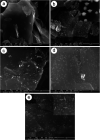Electroless plating of a Sn-Ni/graphite sheet composite with improved cyclability as an anode material for lithium ion batteries
- PMID: 35539458
- PMCID: PMC9079991
- DOI: 10.1039/c8ra01940a
Electroless plating of a Sn-Ni/graphite sheet composite with improved cyclability as an anode material for lithium ion batteries
Abstract
A Sn-Ni/graphite sheet composite is synthesized by a simple electroless plating method as an anode material for lithium ion batteries (LIBs). The microstructure and electrochemical properties of the composite are characterized by field emission scanning electron microscopy (FE-SEM), transmission electron microscopy (TEM), cyclic voltammetry (CV), and AC impedance spectroscopy. The results show that the as-prepared composite has Sn-Ni nanoparticles around 100 nm in size, where metallic Ni acts as an "anchor" to fix metallic Sn. The reunion phenomenon of Sn is alleviated by adding metallic Ni between the metallic Sn and graphite sheets. The Sn-Ni/graphite sheet electrode exhibits a good rate performance with a capability of 637.4, 586.3, 466.7, 371.5, 273.6, 165.3 and 97.3 mA h g-1 at a current density of 0.1, 0.2, 0.5, 1.0, 2.0, 5.0 and 10 A g-1, respectively. The good electrical conductivity of Ni, high specific capacity of Sn and excellent cycling capability of the graphite sheets have a synergistic effect and are the main reasons behind the superior electrochemical performance. Furthermore, the as-prepared composite exhibits excellent lithium storage capacity and the reversible capacity increased as the cycle number increased.
This journal is © The Royal Society of Chemistry.
Conflict of interest statement
There are no conflicts to declare.
Figures







Similar articles
-
Facile mechanochemical synthesis of nano SnO2/graphene composite from coarse metallic Sn and graphite oxide: an outstanding anode material for lithium-ion batteries.Chemistry. 2014 Apr 1;20(14):4055-63. doi: 10.1002/chem.201304720. Epub 2014 Feb 25. Chemistry. 2014. PMID: 24616072
-
Self-Assembled Framework Formed During Lithiation of SnS2 Nanoplates Revealed by in Situ Electron Microscopy.Acc Chem Res. 2017 Jul 18;50(7):1513-1520. doi: 10.1021/acs.accounts.7b00086. Epub 2017 Jul 6. Acc Chem Res. 2017. PMID: 28682057
-
Three-Dimensional Flower-like MoS2 Nanosheets Grown on Graphite as High-Performance Anode Materials for Fast-Charging Lithium-Ion Batteries.Materials (Basel). 2023 May 27;16(11):4016. doi: 10.3390/ma16114016. Materials (Basel). 2023. PMID: 37297150 Free PMC article.
-
A nanostructured SnO2/Ni/CNT composite as an anode for Li ion batteries.RSC Adv. 2021 Jun 1;11(32):19531-19540. doi: 10.1039/d1ra01678d. eCollection 2021 May 27. RSC Adv. 2021. PMID: 35479220 Free PMC article.
-
Metallic Sn-Based Anode Materials: Application in High-Performance Lithium-Ion and Sodium-Ion Batteries.Adv Sci (Weinh). 2017 Sep 22;4(11):1700298. doi: 10.1002/advs.201700298. eCollection 2017 Nov. Adv Sci (Weinh). 2017. PMID: 29201624 Free PMC article. Review.
Cited by
-
Rational Construction of C@Sn/NSGr Composites as Enhanced Performance Anodes for Lithium Ion Batteries.Nanomaterials (Basel). 2023 Jan 9;13(2):271. doi: 10.3390/nano13020271. Nanomaterials (Basel). 2023. PMID: 36678024 Free PMC article.
References
-
- Cao K. Li P. Zhang Y. Chen T. Wang X. Zhang S. Liu J. Wang H. Nano Energy. 2017;40:187–194. doi: 10.1016/j.nanoen.2017.07.042. - DOI
-
- Chen J. Yano K. ACS Appl. Mater. Interfaces. 2013;5:7682–7687. - PubMed
-
- Cheng Y. Yi Z. Wang C. Wu Y. Wang L. Chem. Eng. J. 2017;330:1035–1043. doi: 10.1016/j.cej.2017.08.066. - DOI
-
- Leng J. Wang Z. Li X. Guo H. Li H. Shih K. Yan G. Wang J. J. Mater. Chem. A. 2017;5:14996–15001.
-
- Li T. Li X. Wang Z. Guo H. Li Y. Wang J. J. Mater. Chem. A. 2017;5:13469–13474.
LinkOut - more resources
Full Text Sources

